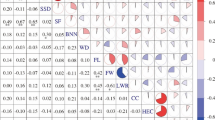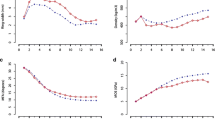Abstract
Chir pine (Pinus roxburghii) is an important tree species that grows all along the Himalayas. Wood specific gravity of chir pine before and after removal of extractives from wood increment cores was assessed from a 22-years-old progeny test in Himachal Pradesh, India. These values averaged 0.433 and 0.425, respectively. A large amount of genetic variation among the 58 half-sib families was found as indicated by range of values, additive coefficient of variation, variance estimates and narrow-sense heritability values for these traits. Moisture and extractive content averaged 86.259% of oven-dry weight and 2.003% of extractive-free oven-dry weight, respectively. Wood extractive content was highly variable and the family differences were highly heritable (h 2f = 0.5831). There was wide variability in moisture content, but a large portion of it was due to environmental or non-additive component of genetic variation. Heritability on family mean basis was found to be lower than that on individual tree basis for each trait. Estimated gain in specific gravity resulting from 30 to 50% family selection ranged from 0.0080 to 0.0127. Growth data and specific gravity were not significantly correlated implying that selection for higher growth rate would not necessarily result in reduction in wood specific gravity in chir pine.



Similar content being viewed by others
References
Blada I (1994) Performance of open-pollinated families of blue pine in Romania. Silvae Genet 43(4):231–238
Bray MW (1928) Chemical analysis of pulp and plywood. Paper Trade J 87:59–68
Cavalli-sforza LL, Feldman MW (1976) Evolution of continuous variation: direct approach through joint distribution of genotypes and phenotypes. Proc Nat Acad Sci USA 73(5):1689–1692. (http://www.pnas.org/content/73/5/1689.full.pdf)
Comstock RE, Moll RH (1963) Genotype environment interactions. In: Hanson WD, Robinson HR (eds) Statistical genetics and plant breeding. Nat Acad Sci Publ 982, Washington, pp 166–196
Dogra DK (1985) Selection of superior phenotypes in Pinus roxburghii Sarg. from Himachal Pradesh. M.Sc Thesis, Himachal Pradesh Krishi Vishwa Vidyalaya, Palampur (HP)
Dorman KW, Squillace AE (1974) Genetics of slash pine. USDA Forest Service Research Paper WO-20, pp 1–20
Falconer DS, Mackay FC (1996) Introduction to quantitative genetics, 4th edn. Longman, London
Gardner CO (1963) Estimates of genetic parameters in cross fertilizing plants and their implications in plant breeding. In: Hanson WD, Robinson HR (eds) Statistical genetics and plant breeding. Nat Acad Sci Publ 982, Washington, pp 225–252
Haygreen JG, Bowyer JL (1996) Forest products and wood science—an introduction, 3rd edn. Iowa State University Press, Iowa
Hinrichs AL, Culverhouse R, Jin CH, Suarez BK (2007) Linkage and association analysis of principal components in expression data. BMC Proc 1:S46. (www.pubmedcentral.nih.gov/articlerender.fcgi?artid=2367470)
Khosla PK, Sareen TS, Sharma JC, Khurana DK (1988) Intra specific variation in Pinus roxburghii Sargent growth and wood characteristics in needle colour morphotypes. J Tree Sci 7(2):79–84
Koch L, Fins L (2000) Genetic variation in wood specific gravity from progeny tests of ponderosa pine (Pinus ponderosa Laws.) in Northern Idaho and Western Montana. Silvae Genet 49(4/5):174–181
Matziris DI (2000) Genetic variation and realized genetic gain from aleppo pine tree improvement. Silvae Genet 49(1):5–10
McKeand SE (1978) Analysis of half-sib progeny tests of black walnut. MS Thesis, Perdue University, Lafayette
Mebrathu T, Hanover JW (1989) Heritability and expected gain estimates for traits of black locust in Michigan. Silvae Genet 38(3/4):125–130
Moura VPG, Dvorak WS, Nogueira MVP (1998) Variation in wood density, stem volume and dry matter of the Mountain Pine Ridge, Belize, provenance of Pinus tecunumanii grown at Planaltina, Brazil. Scientia Forestalis 53:7–14
Mutton DB (1962) Wood resins. In: Hillis WE (ed) Wood extractives. Academic Press, New York, pp 331–363
Nimkar AU (2000) Evaluation of high resin yielders in chir pine (Pinus roxburghii Sargent) for wood and oleoresin characteristics. Ph.D. Thesis, Dr Y S Parmar University of Horticulture and Forestry, Solan
Panchen AJ, de Zeeuw C (1970) Text book of wood technology. McGraw Hill, New York
Rafii MY, Rajanaidu N, Jalani BS, Kushairi A (2002) Performance and heritability estimations on oil palm progenies tested in different environments. J Oil Palm Res 14(1):15–24
Ritland K (1989) Correlated matings in the partial selfer Mimulus guttatus. Evolution 43:848–859
Sagwal SS (1978) Genetic variation and selection of plus tree in chir (Pinus roxburghii) of Himachal Pradesh. M.Sc Thesis, Himachal Pradesh Krishi Vishwa Vidyalaya, Agriculture Complex, Solan
Sanjeev Kumar (1989) Half-sib progeny evaluation in Pinus roxburghii Sarg. M.Sc Thesis, Dr Y S Parmar University of Horticulture and Forestry, Solan
Sebbenn AM, Arantes FC, Boas OV, Freitas MLM (2006) Genetic variation in an international provenance-progeny test of Pinus caribaea Mor. var. bahamensis Bar. et Gol., in São Paulo, Brazil. Silvae Genet 57(4/5):181–187
Sehgal RN, Chauhan SK, Dhall SP (1995) Half-sib progeny evaluation in chirpine. Silvae Genet 44(2):61–62
Sharma RS (2001) Studies on genetic variation in half-sib progeny evaluation in Pinus roxburghii Sarg. Ph.D. Thesis, Dr Y S Parmar University of Horticulture and Forestry, Solan
Silva JCE, Wellendorf H, Pereira H (1998) Clonal variation in wood quality and growth in young sitka spruce (Picea sitchensis (Bong.) Carr.): estimation of quantitative genetic parameters and index selection for improved pulpwood. Silvae Genet 47(1):20–33
Squillace AE (1974) Average genetic correlations among offspring from open-pollinated forest trees. Silvae Genet 23(5):149–156
Stonecypher RW (1992) Computational methods. In: Fins L, Friedman ST, Brotschol JV (eds) Handbook of quantitative forest genetics. Kluwer, Dordrecht, pp 198–228
Tewari DN (1994) A monograph of chir pine (Pinus roxburghii Sarg.). International Book Distributors, Dehra Dun
Uniyal DP, Verma SK, Sharma SK, Sharma VK (2002) Provenance variation in the specific gravity of wood of chir pine (Pinus roxburghii Sarg.). Ind For 128(12):1295–1301
Vargas-Hernandez J, Adams WT (1991) Genetic variation of wood density components in young coastal Douglas-fir: implications for tree breeding. Can J For Res 21(12):1801–1807
Weston FM, Peter SS, Gabriel H (2008) Genetic parameter estimates for growth and form traits in common ash (Fraxinus excelsior L.) in a breeding seedling orchard at Little Wittenham in England. New For 36(3):225–238
Williams ER, Matheson AC, Harwood CE (2002) Experimental design and analysis for tree improvement, 2nd edn. CSIRO Publishing, Collingwood
Wright JW (1976) Introduction to forest genetics. Academic Press, New York
Yao TS, Simmons VL, Schott RG (1953) Heritability of fur characters and birth weight in karakul lambs. J Anim Sci 12:431–439
Zobel BJ (1964) Breeding for wood properties in forest trees. In: Matthews JD (ed) FAO/IUFRO meeting on forest genetics. Unasylva, pp 73–74. (www.fao.org.docrep/03650E/03650e0a.htm.)
Zobel BJ, Jett JB (1995) Genetics of wood production. Springer, Berlin
Zobel B, Talbert J (1984) Applied forest tree improvement. Wiley, New York
Zobel BJ, van Buijtenen JP (1989) Wood variation—its causes and control. Springer, Berlin
Acknowledgments
The first author is thankful to Sher-e-Kashmir University of Agricultural Sciences and Technology of Kashmir (SKUAST-K) for the sabbatical granted during the study period. We also thank Professor Lauren Fins, University of Idaho, USA for her help during laboratory work and Dr Randy Johnson, National Programme Leader, Genetic and Silviculture Research, USDA Forest Service for his valuable suggestions while estimating heritabilities. We also thank Dr SP Dhall, Ex Professor-Emeritus of statistics, Dr YSP University of Horticulture and Forestry, Solan, for his valuable statistical inputs during the revision of the manuscript.
Author information
Authors and Affiliations
Corresponding author
Rights and permissions
About this article
Cite this article
Raj, A., Sehgal, R.N., Sharma, K.R. et al. Genetic variation in wood specific gravity among half-sib families of chir pine (Pinus roxburghii sargent). New Forests 40, 213–227 (2010). https://doi.org/10.1007/s11056-010-9195-y
Received:
Accepted:
Published:
Issue Date:
DOI: https://doi.org/10.1007/s11056-010-9195-y




